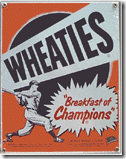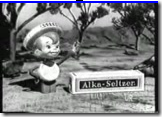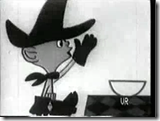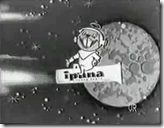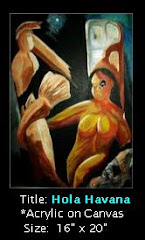
Lucille Ball and Richard Denning performing in
My Favorite Husband
In 1948, television was still pretty much an experimental medium, with only a few hundred thousand television sets able to receive programming in the United States.
Few homes had these new-fangled (and expensive) devices, and most people's first exposure to television came from bars that had installed them, or from display windows of electronics shops.

In 1948, there were only 36 TV stations broadcasting in 19 American cities. Radio, at least for the next couple of years, would remain king in the home entertainment arena.
Shows like Escape!, The Falcon, Fibber McGee & Molly, Duffy's Tavern, and The Whistler were popular fare in the late 1940's.
Although all genre's were popular - everything from westerns to murder mysteries and horror -family oriented situational comedies, like The Life of Riley, The Adventures of Ozzie and Harriet were increasingly popular.
One such show was an early vehicle for two Hollywood actors who had, thus far, seen limited success. It was called My Favorite Husband - and it would serve as a prototype for the biggest television success story of all - I Love Lucy.
But before we loved Lucy, Lucille Ball was a struggling actress.
Born in 1911, an 18 year-old Lucille Désirée Ball began as a model in 1929. In the early 1930's she worked a bit on Broadway under the name "Diane Belmont".
As a contract player for RKO Radio Pictures, Ball had many small, often uncredited, roles in `B' movies. If a director needed a tall, leggy, young lady to play a model, or a slave girl, or some other minor part - Lucille Ball was often cast.

Just a few of the better known movies she appeared in include:
Her biggest early success came from in the hit film Stage Door (1937) co-starring Katharine Hepburn and Ginger Rogers. She was then signed by MGM, and continued to appear in films, but never became the success that she and others had hoped for.
While she appeared in many films during the 1940's, few are memorable. Some of the more notable ones included:
Along the way, Ball augmented her film work by working on the radio - usually in small, supporting roles.
In 1940, Ball would meet Cuban born bandleader Desi Arnez while filming a forgettable version of the Broadway Hit, Too Many Girls. This would begin a successful, but tumultuous union that would span two decades.
By 1948, now in her late thirties, Ball accepted the role of Liz Cugat (later changed to `Cooper'), a wacky wife on the CBS radio sitcom My Favorite Husband.
Richard Denning, who played her husband, was a relatively little known actor who had - like Ball - mostly done `B' movies. He'd won a radio contest in the late 1930's called "Do You Want to Be an Actor?", which gave him a screen test at Warner Brothers.
Warners passed on him, but Paramount took him on under contract.
They changed his name from Denninger (it sounded too much like Dillenger), and he worked fairly steadily throughout the 1940's in such blockbusters as:
Radio work might not have been as glamorous as Hollywood film acting, but it did pay the bills.
In the early 1950's, CBS, seeing how successful the radio show had become, asked Ball to develop it for Television. Ball Agreed, but insisted on having Desi play her husband.
The network was very skeptical that America was ready for an All-American Redhead married to a Cuban, but Ball insisted.
Ball and Arnez formed Desilu Productions and filmed a pilot, but the network wasn't impressed.
Ball and Arnez took the show on the road, performing on the Vaudeville circuit, using the `Lucy want's to get into show business' plot. The show was a big success, and CBS eventually took a chance on Lucy.
But we're ahead of ourselves a bit.
Back to 1948. And the prototype for I Love Lucy.
The OTR.NETWORK library has 65 episodes of My Favorite Husband available for you to listen to, or download.
Here are just the first 20.
# Airdate Episode Name Notes
1 1942-01-25 Marriage License Error (23 min)
2 1948-07-05 First Show (30 min)
3 1948-07-19 Mother's Suprise (30 min)
4 1948-07-99 The Kissing Booth (30 min)
5 1948-08-06 The Portrait Painter (30 min)
6 1948-08-20 Liz Teaches Samba (24 min)
7 1948-09-03 Liz's Mother's Boyfriend (30 min)
8 1948-09-14 General Timberlake (30 min)
9 1948-09-24 Baby Booties (30 min)
10 1948-10-03 The 10th Wedding Anniversary
11 1948-11-06 Katy and Roscoe (23 min)
12 1948-11-13 Learning to Drive (28 min)
13 1948-11-20 Teenage Dating (23 min)
14 1948-11-27 Is There a Baby in the House
15 1948-12-25 Numerology (23 min)
16 1949-01-07 Over Budget (27 min)
17 1949-01-14 Piano Lessons (23 min)
18 1949-01-21 Marriage Licenseerror (23 min)
19 1949-01-28 Absolute Truth (25 min)
20 1949-02-04 Speech for Civic Group (25 min)
And 45 more episodes HERE.
While Lucy would become a television fixture for the next 3 decades, Richard Denning would go on to star in his own, moderately successful Television Series, Mr. and Mrs. North.
He would also star in some well remembered (by some of us, anyway), if not critically acclaimed movies, such as Creature from the Black Lagoon (1954) and The Black Scorpion (1957).
He retired from Hollywood to Hawaii in the late 1960's, but appeared in more than 70 episodes of Hawaii 5-0 (as the Governor) during the 1970's.


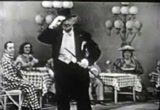
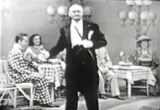

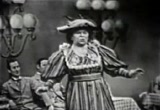


![[movies]](http://www.archive.org/images/mediatype_movies.gif)






